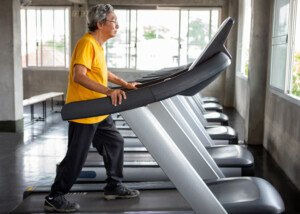
Who’d ever think that walking on a treadmill can cause stress fractures to the feet, but it actually can.
Does this mean that if you’ve never had a stress fracture in your foot, that you should give up walking on a treadmill as a pre-emptive move?
Of course not. You can still keep using this machine, but there are guidelines that you should adhere to, says Barbara Bergin, MD, board certified orthopedic surgeon at and co-founder of Texas Orthopedics, Sports & Rehabilitation Associates.
“Excessive treadmill walking, regardless of holding on or not, can result in stress reactions and stress fractures in the feet,” says Dr. Bergin.
The human machine was meant to walk a lot more than sit a lot. We are designed for lots of walking, as this is what our primitive ancestors had to do all day long to survive.
But people in ancient times took rests. Unlike herds of animals, humans did not trek continuously over miles of savanna without a break.
Treadmill vs. Natural Walking and Stress Fractures
“Remember, treadmill walking is not natural walking,” says Dr. Bergin. “There is almost no natural circumstance in which a person walks continuously uphill for an hour.”
Though people do this for exercise, the key words here are “natural circumstance.” Hunter-gatherers of the distant past as well as currently in certain parts of the world do not walk continuously uphill for an hour, nor do they walk nonstop on level ground for this long. They take ample breaks.
Granted, in some cultures there is continuous walking on country-type roads – to and from a place of work. Kids have been known to walk large distances to and from school in impoverished regions.
But just because such individuals typically do not develop stress fractures in their feet doesn’t mean that the treadmill is no different.
When we apply long-distance walking to the treadmill, things get different. This is why walking three hours nonstop on a treadmill is not an effective way to train for an outdoor walk-a-thon.
“And again, remember that it’s the surface that is moving,” says Dr. Bergin. “It alters the gait. I’ve been seeing an uptick in stress fractures and stress reactions in the feet in patients who do a lot of walking and running on a treadmill.
“I think this is because in Texas, the heat is really prohibitive in terms of running outside during daylight hours.”
Should You Give up Walking on a Treadmill out of Fear of Foot Stress Fractures?
Dr. Bergin advises, “I recommend alternating treadmill with regular walking. And slow down on the treadmill. Diminish the inclination as well.”
It’s understandable when using a treadmill is much more convenient than exercising outside due to weather or time of day.
But when you can, you’ll actually get a more efficient workout if you walk outside.
One of the reasons for the increased efficacy is that you won’t be tempted to hold onto anything.

cancer.gov/NCI
Whereas on a treadmill, the temptation to hold on is overwhelming for many users including young, very able-bodied people.
The mindset for many is that if the rails and front bar are there, you should hold onto them.
Momentarily holding on to steady yourself while drinking water or turning to talk to someone, or to get a heart rate reading, is not the same as continuous holding on.
Keeping your hands continuously on the machine adversely alters gait mechanics and posture.
This includes the natural foot-strike on the tread surface. So even though a hands-free walk of excessive lengths of time can put certain individuals at higher risk of stress fractures, holding onto the treadmill will further raise this risk.
Don’t think for a second that holding onto the machine will lower the risk of developing any kind of stress fracture!
What is a stress fracture?
It’s a tiny crack in a bone, though the bone remains in place. The foot has many small bones that can develop one of these little cracks.
No cast is needed for healing. It heals with rest and avoidance of the offending activity.
Most people who walk on a treadmill will not develop a stress fracture, especially if they wear supportive footwear.
But avid users of this equipment should be interested in knowing what may happen with excessive use.

Dr. Bergin is a general orthopedist, surgically and conservatively treating all manner of bone and joint conditions. She enjoys educating patients so they can emerge stronger than they were before their orthopedic injury or surgery.
 Lorra Garrick has been covering medical, fitness and cybersecurity topics for many years, having written thousands of articles for print magazines and websites, including as a ghostwriter. She’s also a former ACE-certified personal trainer.
Lorra Garrick has been covering medical, fitness and cybersecurity topics for many years, having written thousands of articles for print magazines and websites, including as a ghostwriter. She’s also a former ACE-certified personal trainer.
.









































